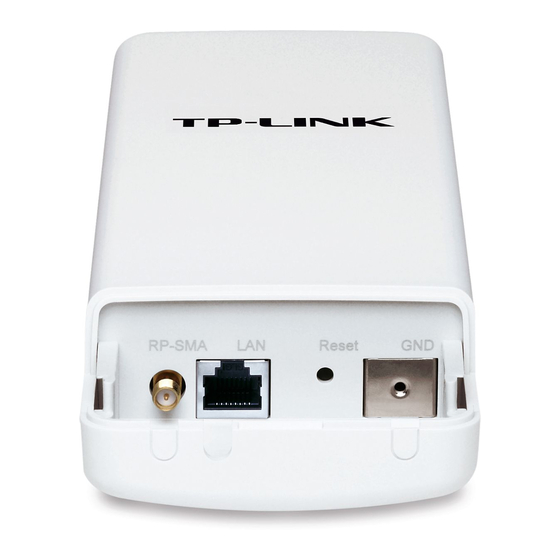Table of Contents
Advertisement
Quick Links
Installation
1
Typical Network
TL-WA7510N is used for remote point-to-point connection. It makes remote
Internet share possible.
The typical connection for TL-WA7510N is shown as above. Please make
Note
sure that the two CPEs are placed face to face; otherwise the wireless
signal strength might be weak. Here shows several incorrect examples.
If you are using an external antenna to connect, please refer to Appendix 1.
Note
1
Advertisement
Table of Contents

Summary of Contents for TP-Link TL-WA7510N
- Page 1 Typical Network TL-WA7510N is used for remote point-to-point connection. It makes remote Internet share possible. The typical connection for TL-WA7510N is shown as above. Please make Note sure that the two CPEs are placed face to face; otherwise the wireless signal strength might be weak.
-
Page 2: Connecting The Device
Connecting the Device Please use only wired network connections to configure the AP. Note Locate a suitable mounting site for your CPE. For choosing the best location, select an elevated location where trees, buildings and large steel structures will not obstruct the antenna signals and which offers maximum line-of-sight propagation with the users. - Page 3 The connection will be similar to the figure below after the above steps are finished. If you use two CPEs to build the network, please make sure that the two CPEs are placed face to face. Turn on all your network devices and then check to see if the LEDs on the AP display normally as the diagram below describes.
-
Page 4: Configuring The Device
Configuring the Device You will need to assign your computer a Static IP address within the same Note range as the AP’s IP address. See the Appendix 2: Troubleshooting - T3 i f you need any assistance. Login Open your web browser and type in http://192.168.1.254 in the address bar and then press Enter A dialog box will prompt you for the... - Page 5 Operation Mode Setting This page will then display. Click Next Choose the Operation Mode Type appropriate to your needs Click Next The AP supports three operation modes: Standard AP, AP Router and A P Note Client Router. a) If you want to connect to your WISP, please choose A P Client Route r mode and proceed to A b) If you want to configure a point-to-point connection, please skip to B;...
- Page 6 AP completes rebooting. After that the changes will take effect. Click Finish Configuration for Point-to-Point Connection Two TL-WA7510N Access Points are needed for this application. Note 1) The AP Setting Select Standard AP Click Next...
- Page 7 After that the changes will take effect. Click Finish 2) The Client Setting After your successful login, please configure the other TL-WA7510N by following the steps below. You should change the default LAN IP address of the Client from Note 192.168.1.254 to 192.168.1.X (X can be any number from 2 to 253) to avoid...
- Page 8 This page will then display. Find the SSID you have configured on the first AP Click Connect Then it will automatically paste the SSID value into the SSID field, and BSSID value into the MAC of AP field Click Save The BSSID is the same as the MAC address.
- Page 9 Then it will automatically paste the BSSID you’ve connected into the MAC of AP field Click Save The BSSID is the same as the MAC address. Note Antenna Alignment A fter basic configuration of operation mode, you can adjust your CPE’s direction to get a better signal strength according to the parameters shown on the Antenna Alignment page.
-
Page 10: Appendix 1: External Antenna Installation
2. If you have an external antenna with N type port, you could connect it to the TL-WA7510N with a pigtail cable. To protect your product, you could also add a surge protector. The complete connection would be simply illustrated as below. - Page 11 A dialog box will prompt you for the User name and Password. Ente r the default values and click OK. User name: admin Password: admin Click OK Configure the External Antenna Click Wireless >Wireless Advanced Select External Antenna Click Save...
-
Page 12: Appendix 2: Troubleshooting
Appendix 2: Troubleshooting How do I restore my AP’s configuration to its factory default settings? With the AP powered on, press and hold the Reset button for about 8 seconds before releasing it. Hold it in for about 8 seconds Once the AP is reset, the current configuration settings will be lost and you Note will need to reconfigure the AP. - Page 13 Click Change adapter settings Right-click Local Area Connection Click Properties Double-click Internet Protocol Version 4 (TCP/IPv4)
- Page 14 Select Use the following IP address Enter 192.168.1.100 into the IP address field, 255.255.255.0 into the Subnet mask field Select Use the following DNS server addresses Enter the DNS server address provided by your ISP or network administrator Click OK For Windows XP OS Go to Start >...
- Page 15 Click Network Connections Right-click Local Area Connection Click Properties Double-click Internet Protocol ( TCP/IP )
- Page 16 Select Use the following IP address Enter 192.168.1.100 into the IP address field, 255.255.255.0 into the Subnet mask field Select Use the following DNS server addresses Enter the DNS server address provided by your ISP or network administrator Click OK...
-
Page 17: Technical Support
For all other technical support, please contact us by using the following details: Global Australia & New Zealand Tel: +86 755 26504400 Tel: AU 1300 87 5465 E-mail: support@tp-link.com NZ 0800 87 5465 Service time: 24hrs, 7 days a week E-mail: support@tp-link.com.au Service time: 24hrs, 7 days a week...








